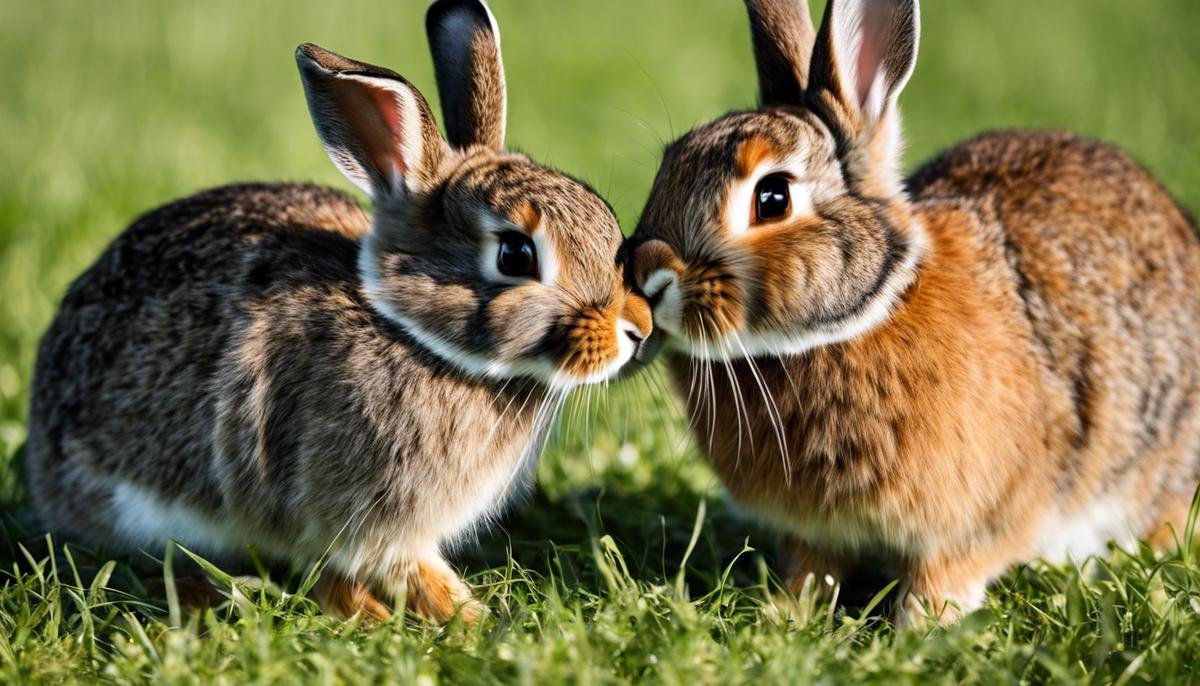When a fluffy rabbit gently licks your hand, it’s not just a small act of curiosity but a window into the complex world of lagomorph social dynamics. The act, endearing as it may seem, goes beyond mere affection, revealing layers about rabbit social behavior and bonding that are often invisible to the casual observer. This exploration takes us down the warren of rabbit social structure, unveiling how grooming and licking are not simple behaviors, but rather, critical components of communication and social integration – both among rabbits and between rabbits and their human companions. As we embark on this journey, let’s delve into the natural instincts that drive these gentle creatures to form bonds, maintain hierarchies, and express their affinity through such tactile interactions.
Rabbit Social Behavior and Bonding
Rabbit Social Dynamics and the Role of Licking
The social behavior of rabbits is multifaceted, encompassing a variety of interactions that are critical to their communal living and affinity structures. Among these behaviors, licking stands out as a significant gesture, akin to grooming in primates – a pivotal method for bonding and affirming social hierarchies. This act, commonly known as ‘allogrooming,’ plays an essential role in the formation and maintenance of relational bonds among rabbit groups and contributes to the overall harmony and cohesion within the warren.
Licking serves as both a functional and symbolic token of affection and social connection. Functionally, rabbits engage in mutual grooming to clean areas that are difficult to reach by oneself, such as the face and ears, aiding in hygiene and parasite control. Symbolically, licking operates as a gesture of social ease, affection, and subordination. It is often observed that subordinate rabbits will initiate allogrooming as an offering of peace or to appease more dominant members. The reciprocal nature of licking extends its function beyond mere hygiene, as it is also a vital nonverbal communication tool that reinforces social structures and conveys trust and companionship.
In the labyrinthine social environment of rabbit colonies, licking communicates more than just care; it establishes and reaffirms the complex social ties that are so incredibly crucial to their psychological well-being. Higher-ranking rabbits often receive grooming from their inferiors, reinforcing the existing social stratification while also providing a comforting mechanism that mitigates stress and potential conflict within the group. This behavior highlights the nuanced understanding that rabbits possess regarding their social surroundings, demonstrating the sophisticated nature of their social organization. Through licking and mutual grooming, rabbits express a tangible sense of community, caring, and connection, weaving the fabric of their social reality.

Anthropomorphism and Misinterpretation of Rabbit Behavior
Anthropomorphism, the attribution of human traits, emotions, or intentions to non-human entities, can significantly skew our interpretation of animal behaviors, particularly those of rabbits. By projecting our human emotions and social rituals onto these creatures, we risk misunderstanding their natural actions and needs. One behavior often misinterpreted is a rabbit’s licking.
While from a human perspective, licking might be viewed as a sign of affection akin to kissing or a sign of seeking attention, in rabbits, this behavior often serves different social functions. Licking in rabbits is primarily a grooming gesture that goes beyond surface cleanliness—it is an integral part of their social hierarchy and bonding process. Given a rabbit’s limited repertoire of communication, licking among these lagomorphs may signal submission to a dominant partner or serve as a reaffirmation of social bonds within a group. Observers who impose a human framework onto these actions may misconstrue them as solely displays of fondness, which could lead to inappropriate responses that disrespect the animal’s instinctual boundaries and social order.
In interpreting these behaviors, it is crucial to rely on ethological principles, which emphasize the study of animal behavior in a natural context, instead of anthropocentric interpretations. For instance, when a rabbit licks a human, it may not necessarily be a gesture of affection but rather an exploratory behavior or a sign of comfort with their presence, as humans are often seen as part of their social environment. In addition, licking behaviors may be a rabbit’s way of soliciting grooming in return, which in their social interactions is a reciprocal behavior essential to the cohesion of the rabbit community. Disregarding the natural roots and significance of these actions does a disservice to our understanding and may lead to mismanagement of their welfare and social needs. Therefore, a sound grasp of rabbit ethology over anthropomorphic assumptions ensures the wellbeing of these animals in human care.

Understanding the nuanced behavior of rabbits requires peering into their world with a lens free from human emotion and bias. As we have journeyed through the realms of rabbit social rituals and the intricacies of their interactions with us, it is imperative that we appreciate these behaviors in their truest form. By recognizing the delicate balance between acknowledging their own unique methods of communication and resisting the urge to overlay these actions with human intent or sentiment, we afford these charming companions the respect of being seen for what they truly are. Their licks and nudges are not mere mimicry of human affection; they are the whispers of a language that speaks to the timeless bond shared by all creatures who navigate the tender dance of social connectedness.



